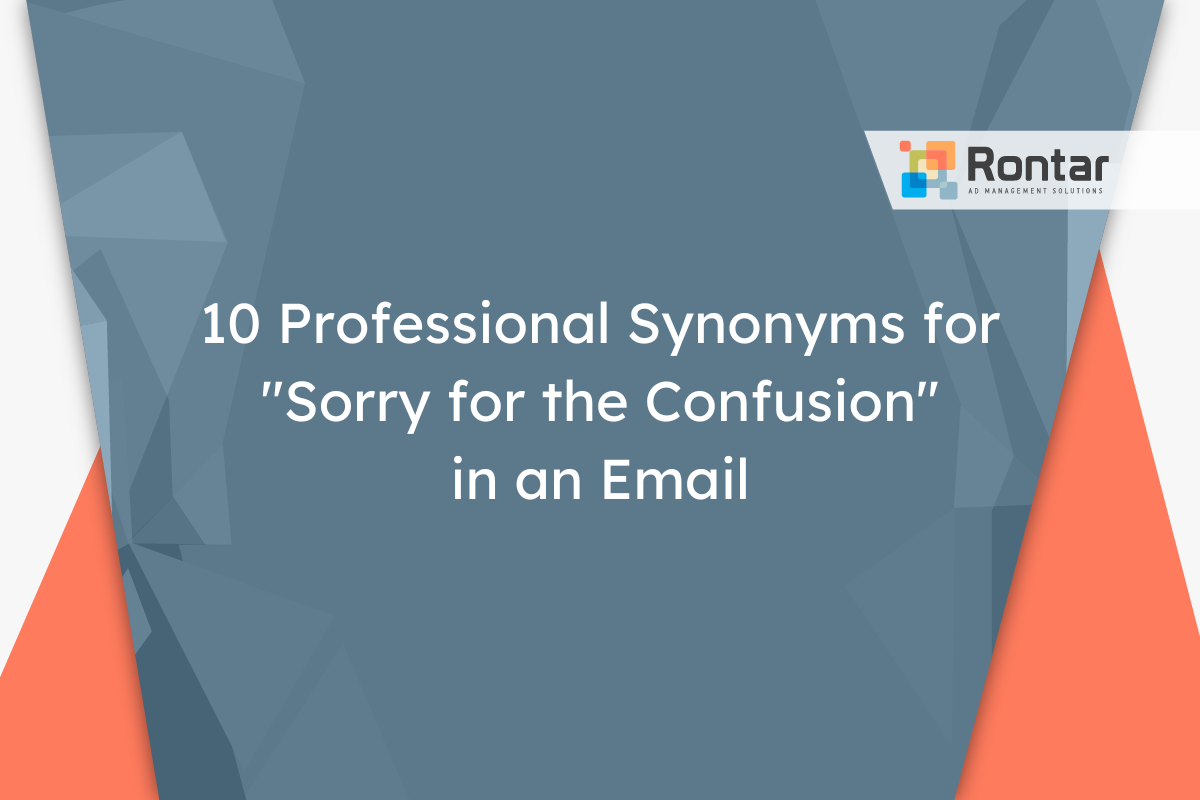10 Professional Synonyms for “Sorry for the Confusion” in an Email

In professional emails, it’s crucial to communicate clearly. But sometimes, misunderstandings happen. When they do, saying “sorry for the confusion” is a polite way to smooth things over.
This article offers 10 alternatives to that phrase, helping you maintain professionalism while apologizing effectively.
Is It Professional to Say “Sorry for the Confusion”?
Saying “sorry for the confusion” is generally considered professional, formal, and polite. This phrase is useful in email communication when you want to acknowledge a misunderstanding or miscommunication. It’s a way of taking responsibility without placing blame. This phrase can be particularly effective in professional settings where maintaining a positive and respectful tone is essential.
One common situation where using this phrase might be appropriate is if there’s been a misunderstanding in the details of a project, leading to confusion among team members or clients. For example, if an email was sent with incorrect information or instructions were unclear, using this phrase can help to smooth over the issue and signal a readiness to correct the misunderstanding.
Here is an example of how to use “sorry for the confusion” in an email:
Hi Lisa, Please disregard my previous email regarding the dates. The correct start date for the next project phase is March 15th, not March 5th. Sorry for any confusion. Best, Michael
Pros:
- Shows accountability and professionalism.
- Helps to defuse potential frustration or anger.
- Opens the door to provide clearer information or instructions.
Cons:
- May be overused to the point of losing its sincerity.
- Could imply that all the blame is on the sender, even when the confusion was mutual.
- Doesn’t provide a solution to the confusion.
Sometimes, a person might look for alternatives to saying “sorry for the confusion” because they want to express their message in a fresher or more precise way. Using synonyms or alternative phrases can help to tailor your response to fit the context more accurately or to avoid repetition if you find yourself in similar situations frequently. Alternatives can also serve to directly address the next steps or solutions, which may provide more value to the recipient than a simple apology.
10 Other Ways to Say “Sorry for the Confusion” in an Email
There are various alternatives to express an apology for misunderstanding in a professional setting. Here’s a list of 10 synonyms that offer a fresh spin on the traditional phrase:
- I apologize for the confusion
- Apologies for the misunderstanding
- Sorry for the misunderstanding
- My apologies for any ambiguity
- Apologies for the miscommunication
- Apologies for the mix-up
- I apologize for any confusion caused
- Sorry for any unclear messaging
- Sorry if I caused confusion
- Sorry for the confusion caused
1. I apologize for the confusion
This alternative to “sorry for the confusion” carries a formal and professional tone. It is slightly more formal because it uses “I apologize” instead of “sorry.” This makes it suitable for communicating with clients or senior management where an error has led to misunderstandings.
It’s better suited for situations where the sender feels a strong responsibility for the mix-up and wants to take full accountability without making the message sound too casual.
Here’s an example of using this alternative in an email:
Hi Mark, I wanted to touch base about the email you received yesterday regarding the meeting time. It seems there was a mistake in the time provided. I apologize for the confusion and for any inconvenience it may have caused. We have rescheduled the meeting for tomorrow at 10 AM. Warm regards, Emily
2. Apologies for the misunderstanding
This version is slightly more informal than the first but still remains polite and professional. It’s best used when the misunderstanding was mutual or when the error wasn’t entirely the sender’s fault.
This phrase is particularly effective in emails where you’re looking to maintain a friendly yet professional tone. It acknowledges the issue without placing blame.
Here is an example of this phrase in action:
Hello Thomas, Thank you for your quick response to the project outline. It appears there was some confusion regarding the deadlines. Apologies for the misunderstanding. To clarify, the final submission date is June 20th. Best, Claire
3. Sorry for the misunderstanding
This phrase is more informal compared to the previous ones, but it still keeps the message polite and professional. It’s a good choice for internal emails where the sender and receiver have a friendly relationship.
When clarity is essential, and you want to quickly address and move past the misunderstanding, this alternative is beneficial. It immediately addresses the issue and opens up the conversation for any needed clarification.
Check out this sample for using “Sorry for the misunderstanding”:
Hi Samantha, Regarding our earlier conversation about the quarterly budget, I may not have been clear about the allocation for marketing. Sorry for the misunderstanding. I’ve attached the detailed budget breakdown for a clearer picture. Thank you, Derek
4. My apologies for any ambiguity
This phrase is quite formal and is suitable when the confusion might have stemmed from the vagueness of the information provided. This expression especially communicates a sincere regret for not being clear enough.
It’s recommended when the information provided was complex and, as a result, led to misconceptions. This synonym demonstrates a high level of responsibility and professionalism.
Here’s a sample message using this phrase:
Dear Dr. Reynolds, It has come to my attention that the instructions provided for the upcoming research protocol were not as clear as they should have been. My apologies for any ambiguity. I have attached a revised document with more detailed instructions. Sincerely, Jordan
5. Apologies for the miscommunication
This option is perfect when the cause of the confusion was a miscommunication either in verbal or written form. It’s formal enough for most professional contexts and shows that you care about clear and precise communication.
When you recognize that the error resulted from poor communication on your part, this phrase can help to mend the situation, showing a willingness to improve and clarify.
For an example of this alternative in use:
Hello Vanessa, During our last meeting, I believe there was a misunderstanding about the project's scope due to the way it was communicated. Apologies for the miscommunication. I’m forwarding the revised project brief for your review. Best regards, Liam
6. Apologies for the mix-up
This alternative is more informal and tends to be used in less formal professional settings or with individuals you have a casual working relationship with. It’s suitable for situations where the confusion was minor and easily resolvable.
This phrase conveys a light-hearted admission of error and is best for situations where keeping the mood friendly and positive is important. A little less formal, but still professional.
Here’s how you might use “Apologies for the mix-up”:
Hi Alex, I’ve noticed that the wrong file was attached in my previous email regarding the sales report. Apologies for the mix-up. Please find the correct file attached to this email. Cheers, Nina
7. I apologize for any confusion caused
This phrase is formal and directly addresses the issue, making it suitable for emails to clients or senior colleagues where clarity and professionalism are paramount. It’s particularly effective when the misunderstanding could have led to inconvenience on their part.
It’s recommended when you want to make a respectful acknowledgment of the mistake and show your commitment to preventing similar issues in the future.
Here’s a sample using this more formal alternative:
Dear Mr. Lawson, There seems to have been an oversight concerning the delivery schedule I outlined in our last correspondence. I apologize for any confusion caused and assure you steps are being taken to correct this immediately. Kind regards, Sophie
8. Sorry for any unclear messaging
This version is a bit more informal but still maintains a professional tone. It’s great for when confusion might be due to the way a message was worded rather than incorrect information.
This is especially suitable in a fast-paced environment where quick emails are common and may occasionally lack full clarity. It acknowledges the oversight without making it a focal point of the conversation.
Here is how it can be included in an email:
Hello Team, After reviewing the feedback on the last project update email, it’s clear that some points may not have been as clear as intended. Sorry for any unclear messaging. A follow-up meeting is scheduled for tomorrow to clarify. Best, Greg
9. Sorry if I caused confusion
This phrase is notably informal and personal. It implies a direct responsibility for the confusion and is typically used when the sender is in a less formal relationship with the recipient, such as a coworker or a team member.
This alternative is well-suited for situations where a direct approach is appreciated, and the relationship allows for a more personal tone. It’s straightforward and fosters open communication.
An example of its usage in an email could be:
Hi Jamie, In my last message about the project deadlines, I might have missed including some critical dates. Sorry if I caused confusion. Here’s the complete timeline for better clarity. Thanks, Casey
10. Sorry for the confusion caused
This alternative strikes a balance between being formal and informal. It clearly takes responsibility for the confusion while maintaining a polite tone. It’s versatile and can be used in various professional settings, depending on the relationship with the recipient.
It’s particularly useful when the sender wishes to express regret for any inconvenience caused directly due to the confusion. This phrasing is both sincere and concise, making it suitable for a wide range of scenarios where an apology is warranted.
And here’s a final example for this list:
Hello Colleagues, It has been brought to my attention that the instructions for the annual report submission were not as clear as they could have been. Sorry for the confusion caused. An updated set of instructions is attached for your convenience. Regards, Ella
Final Thoughts
Choosing the right words when you need to apologize for confusion in an email is important. It shows you care about clear communication and respect the recipient.
The 10 alternatives we’ve shared provide a range of options, from formal to informal, ensuring you can find the right fit for any situation. If your emails or text messages have caused any confusion, the goal is to clear up misunderstandings and keep your professional relationships strong. Using these alternatives can help you do just that, letting you address mistakes without losing respect or credibility.
So, next time you draft an email to address a mix-up, consider these synonyms to keep your message clear, polite, and professional.






